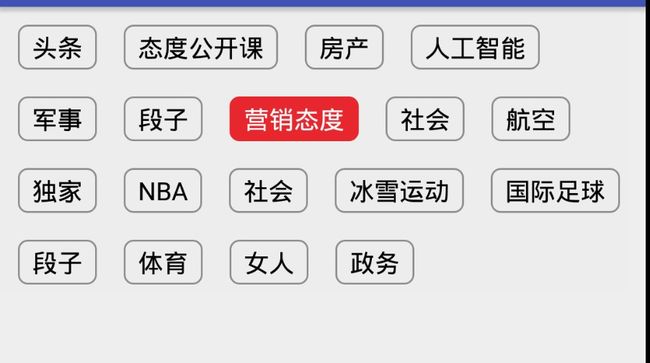前言
关于Flowlayout流式布局 github上随便一搜索就一大堆 而且Google也开源了一个FlexboxLayout布局非常强大 这里只是教大家如何实现的最基本的自定义 剩余的那些花俏就看大家天马行空的扩展就好了 同时懂的大神基本可以路过了
效果
案例Demo
分析:
1. 这是一个ViewGroup
2. 当父容器宽度放不下子view的时候 自动换行
3. 除了子View的宽高还要考虑子View的Margin属性
备注:整个过程涉及的知识点 主要就是View的onMeasure和onLayout 基础偏弱的同学可能需要另外花点功夫学习下
自定义步骤
1.先自定义一个ViewGroup
public class Flowlayout extends ViewGroup{
2.获取子View的Margin属性(这个在ViewGroup中非常方便 重写generateLayoutParams便是)
/**
* 获取布局中的margin属性值
* @param attrs
* @return
*/
@Override
public LayoutParams generateLayoutParams(AttributeSet attrs) {
return new MarginLayoutParams(getContext(),attrs);
}
3.来到我们的重点之一 针对子View的测量 关于View的测量相关方面的知识 这里不做多介绍不明白的同学 可以去Google一下 同时我也把注释尽量写明白
/**用于存放每一行的子View集合*/
private List> mViewLinesList=new ArrayList<>();
/**用于存放每一行的高度*/
private List mLineHeights=new ArrayList<>();
/**
* 测量
* @param widthMeasureSpec
* @param heightMeasureSpec
*/
@Override
protected void onMeasure(int widthMeasureSpec, int heightMeasureSpec) {
super.onMeasure(widthMeasureSpec, heightMeasureSpec);
int widthmMode = MeasureSpec.getMode(widthMeasureSpec);
int widthsize = MeasureSpec.getSize(widthMeasureSpec);
int heightMode = MeasureSpec.getMode(heightMeasureSpec);
int heightSize = MeasureSpec.getSize(heightMeasureSpec);
int measuredWith = 0;
int measuredHeight = 0;
int curLineW=0;
int curLineH=0;
if(widthmMode==MeasureSpec.EXACTLY&&heightMode==MeasureSpec.EXACTLY){
measuredHeight=heightSize;
measuredWith=widthsize;
}else {
int childWidth;
int childHeight;
//获取所有的子View
int childCount = getChildCount();
//创建一个集合用于存放每一行的子View
List viewList=new ArrayList<>();
//遍历
for(int i=0;iwidthsize){
//记录当前最大宽度
measuredWith=Math.max(measuredWith,curLineW);
//高度累加
measuredHeight+=curLineH;
//将该View添加到List集合
mViewLinesList.add(viewList);
//行高添加至总行高
mLineHeights.add(curLineH);
//记录新一行的信息
curLineW=childWidth;
curLineH=childHeight;
//新建一行的ViewList 添加一行新view
viewList=new ArrayList<>();
viewList.add(childAt);
}else {
//累加宽度
curLineW+=childWidth;
//高度比较 获取最大的高度
curLineH=Math.max(curLineH,childHeight);
//添加到该行集合
viewList.add(childAt);
}
//如果是最后一个view的时候(特别针对最后一行view只有一两个的 因为他们的宽度是不可能超过父容器的宽度的)
if(i==childCount-1){
measuredWith=Math.max(measuredWith,curLineW);
measuredHeight+=curLineH;
//将该View添加到List集合
mViewLinesList.add(viewList);
//行高添加至总行高
mLineHeights.add(curLineH);
}
}
}
setMeasuredDimension(measuredWith,measuredHeight);
}
4.重点之二 View的布局 上面一步是把View的宽高测量出来了 这个一步将确定子View在父容器中位置 重写onLayout 进行布局
@Override
protected void onLayout(boolean changed, int l, int t, int r, int b) {
int left,top,right,bottom;
int curTop=0;
int curLeft=0;
int size = mViewLinesList.size();
//遍历每一行的view集合
for(int i=0;i views = mViewLinesList.get(i);
int lineViewSize=views.size();
//遍历每一行的所有view
for(int j=0;j 5.到这里基本就完成了 使用在布局中看看效果
6.扩展点击事件 其他的扩展看你们思想发挥了
int index;//保存点击过的index
interface OnItemClickListener{
void onItemClick(String text);
}
public void setOnItemClickListener(final OnItemClickListener onItemClickListener){
int childCount = getChildCount();
for(int i=0;i7.最后效果

